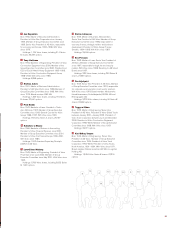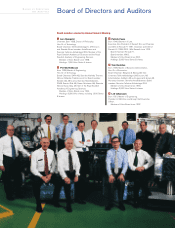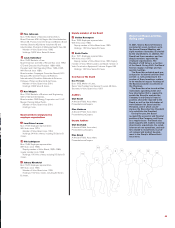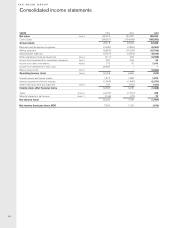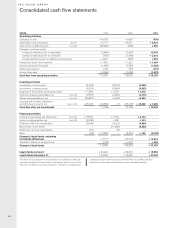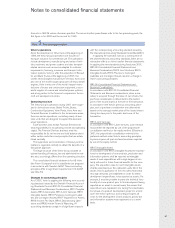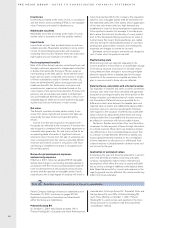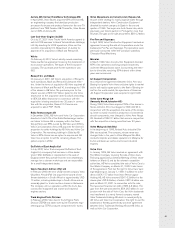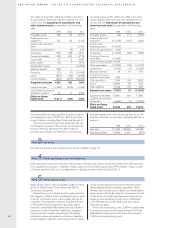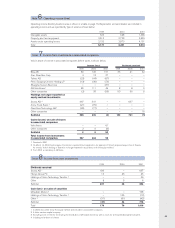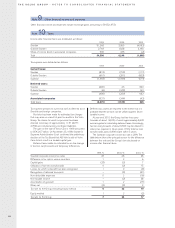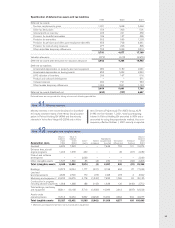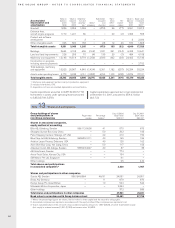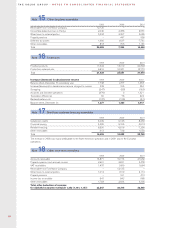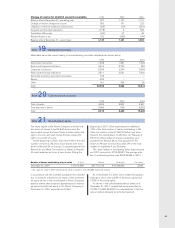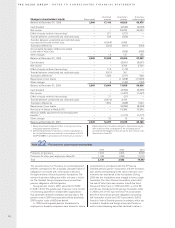Volvo 2001 Annual Report Download - page 64
Download and view the complete annual report
Please find page 64 of the 2001 Volvo annual report below. You can navigate through the pages in the report by either clicking on the pages listed below, or by using the keyword search tool below to find specific information within the annual report.
THE VOLVO GROUP · NOTES TO CONSOLIDATED FINANCIAL STATEMENTS
60
Parent Company holdings of shares in subsidiaries as of
December 31, 2001 are shown on pages 95–96.
Significant acquisitions, formations and divestments
within the Group are listed below.
Prévost Holding BV
On October 1, 2001 Volvo Buses divested 1% of
Prévost Holding BV, a Canadian and North American bus
manufacturer, to Henlys Group Plc. Thereafter Volvo and
Henlys Group Plc own 50% of Prévost Holding BV
each. Thus, effective on October 1, 2001, Prévost
Holding BV is a joint venture and reported in the Volvo
Group accounts in accordance with the proportinate
consolidation method.
Note 2Acquisitions and divestments of shares in subsidiaries
Inventories
Inventories are stated at the lower of cost, in accordance
with the first-in, first-out method (FIFO), or net realizable
value. Provisions are made for obsolescence.
Marketable securities
Marketable securities are stated at the lower of cost or
market value in accordance with the portfolio method.
Liquid funds
Liquid funds include Cash and bank balances and mar-
ketable securities. Marketable securities to some extent
consist of interest bearing securities with maturities
exceeding three months. However, these securities have
high liquidity and can easily be converted to cash.
Post-employment benefits
Most of the Volvo Group’s pension commitments are met
through continuous payments to independent authorities
or bodies that administer the plans. Pension expense
corresponding to the fees paid for these defined-contri-
bution pension plans is reported continuously. In certain
of Volvo’s subsidiaries, mainly in Sweden and the U.S.,
there are defined benefit plans covering pensions and
healthcare benefits. For these plans, a provision and
annual pension expense are calculated based on the
current value of the earned future benefits. Provisions for
pensions and annual expenses related to defined pen-
sion and healthcare benefits are reported in Volvo’s con-
solidated balance sheet and income statement by apply-
ing the local rules and directives in each country.
Net sales
The Group’s reported net sales pertain mainly to rev-
enues from sales of goods and services. Net sales are
reduced by the value of discounts granted and by
returns.
Income from the sale of goods is recognized when
the goods are delivered to the customers. If however the
sale of goods is combined with a buy-back agreement or
a residual value guarantee, the sale is accounted for as
an operating lease transaction if significant risks are
retained in Volvo. Income from the sale of workshop ser-
vices is recognized when the service is provided. Rental
revenues and interest income in conjunction with finan-
cial leasing or installment contracts is recognized over
the contract period.
Research and development expenses
and warranty expenses
Effective in 2001, Volvo has adopted RR15 Intangible
Assets (see changes in accounting principles above). In
accordance with the new accounting standard, expendi-
tures for development of new products and production
systems shall be reported as intangible assets if such
expenditures with a high degree of certainty will result in
future financial benefits for the company. The acquisition
value for such intangible assets shall be amortized over
the estimated useful life of the assets. Volvo’s application
of the new rules means that very high demands are
established in order for these development expenditures
to be reported as assets. For example, it must be possi-
ble to prove the technical functionality of a new product
prior to this development being reported as an asset. In
normal cases, this means that expenditures are capital-
ized only during the industrialization phase of a product
development project. Other research and development
expenses are charged to income as incurred.
Estimated costs for product warranties are charged to
cost of sales when the products are sold.
Restructuring costs
Restructuring costs are reported separately in the
income statement if they relate to a considerable change
of the Group structure. A provision for decided restruc-
turing measures (see changes in accounting principles
above) is reported when a detailed plan for the imple-
mentation of the measures is complete and when this
plan is communicated to those who are affected.
Deferred taxes, allocations and untaxed reserves
Tax legislation in Sweden and other countries sometimes
contains rules other than those identified with generally
accepted accounting principles, and which pertain to the
timing of taxation and measurement of certain commer-
cial transactions. Deferred taxes are provided for on
differences which arise between the taxable value and
reported value of assets and liabilities (temporary differ-
ences) as well as on tax-loss carryforwards. However,
with regards to the valuation of deferred tax assets (the
value of future tax deductions), these items are recog-
nized provided that it is probable that the amounts can
be utilized in connection with future taxable income.
Tax laws in Sweden and certain other countries allow
companies to defer payment of taxes through allocations
to untaxed reserves. These items are treated as tempo-
rary differences in the consolidated balance sheet, that
is, a division is made between deferred tax liability and
equity capital (restricted reserves). In the consolidated
income statement an allocation to, or withdrawal from,
untaxed reserves is divided between deferred taxes and
net income for the year.
Application of estimated values
In preparing the year-end financial statements in accord-
ance with generally accepted accounting principles,
company management makes certain estimates and
assumptions which affect the value of assets and liabili-
ties as well as contingent liabilities at the balance sheet
date. Reported amounts for income and expenses in the
reporting period are also affected. The actual results may
differ from these estimates.



